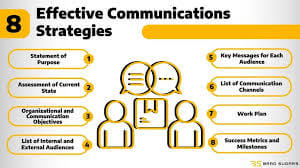In today’s rapidly evolving business landscape, communication is more than just an exchange of information; it is a vital strategy that drives success. Whether within an organization or between businesses and their external stakeholders, effective communication can be the difference between achieving goals and falling short. This is where a well-developed business communication strategy becomes indispensable. It serves as the roadmap for all communication efforts, ensuring that messages are delivered clearly, consistently, and in alignment with the company’s vision.
A business communication strategy is not a one-size-fits-all model. It requires careful planning, tailoring to specific audience needs, and an ongoing commitment to improvement. Whether your business is a small startup or a multinational corporation, communication at all levels must be intentional and strategically managed to ensure alignment across various departments, customer interactions, and external partnerships. This article will provide an in-depth exploration of the importance of a business communication strategy and offer practical insights on how to build and refine one for your organization.
What is a Business Communication Strategy?
At its core, a business communication strategy is a plan that outlines how an organization communicates with its employees, customers, investors, and other stakeholders. It details the messages, channels, tools, and processes that will be used to ensure communication is effective, targeted, and consistent. Without a clear communication strategy, a business can experience confusion, inefficiencies, and missed opportunities.
In an ideal business communication strategy, there is a seamless flow of information that enhances decision-making, boosts employee morale, improves customer relationships, and ultimately supports the company’s objectives. It goes beyond basic communication practices and focuses on creating a framework that aligns communication with the overall business goals.
The Importance of a Business Communication Strategy
Communication is one of the most powerful tools a business has, but without a solid strategy, it can easily become a barrier rather than a catalyst for success. A well-executed business communication strategy is important for several reasons:
- Enhances Productivity: Clear communication reduces misunderstandings, increases the speed of decision-making, and minimizes errors, which all contribute to higher productivity.
- Fosters Collaboration: Whether within teams or between departments, effective communication promotes collaboration, ensuring that everyone works toward common objectives.
- Builds Brand Consistency: A cohesive communication strategy ensures consistency in messaging, helping to build a strong, recognizable brand that resonates with customers.
- Improves Customer Relationships: Consistent and clear communication with customers leads to greater satisfaction and loyalty, which is essential for long-term success.
- Crisis Management: A well-thought-out communication strategy enables organizations to respond swiftly and effectively during a crisis, preserving their reputation and maintaining stakeholder trust.
Defining Clear Communication Objectives
The foundation of a successful business communication strategy begins with establishing clear objectives. What are you aiming to achieve with your communication efforts? These goals could range from improving internal efficiency, enhancing employee engagement, building a positive brand image, or increasing customer satisfaction.
Setting clear objectives helps guide the communication process, ensuring that all messages are tailored to achieve specific outcomes. It also allows businesses to track progress and measure success. By aligning communication objectives with overall business goals, you ensure that each communication initiative serves a larger purpose.
Understanding Your Audience
One of the cornerstones of a successful business communication strategy is understanding your audience. Not all messages are created equal, and different stakeholders have different needs, preferences, and expectations when it comes to communication.
For instance, employees might prefer quick, direct communication via tools like Slack or email, while customers might engage better with more detailed content, such as blog posts or videos. Understanding the preferences of your audience allows you to tailor messages that resonate and achieve the desired impact.
Choosing the Right Communication Channels
Effective communication is not just about the message; it’s also about how that message is delivered. A critical part of your business communication strategy is choosing the right communication channels. In today’s digital age, businesses have a wide range of channels available, from email and social media to video conferencing and instant messaging.
The choice of communication channel should depend on factors such as the type of message, the urgency, and the preferences of the audience. For example, important announcements might be best communicated through a formal email or company-wide meeting, while day-to-day updates can be shared via messaging apps or internal collaboration platforms.
Crafting Clear and Consistent Messages
One of the most important aspects of a business communication strategy is ensuring that messages are clear and consistent. When messages are unclear, recipients may misinterpret them, leading to confusion and errors. Inconsistent messaging, especially across different channels, can damage the credibility of the organization.
A business communication strategy should focus on crafting messages that are concise, direct, and easy to understand. This includes establishing key messages that align with the company’s brand, values, and goals, and ensuring that these messages are communicated consistently across all channels.
Developing an Internal Communication Plan
Internal communication is the backbone of any successful organization. A robust internal communication plan ensures that employees are informed, engaged, and aligned with the company’s objectives. It fosters a culture of transparency and collaboration, where everyone is on the same page.
Key components of an internal communication plan include regular updates, team meetings, employee surveys, and the use of collaboration tools. When employees feel informed and engaged, they are more likely to be productive and motivated.
External Communication and Brand Building
External communication plays a pivotal role in shaping the public perception of your brand. Through strategic communication efforts, businesses can influence how customers, investors, partners, and the general public perceive the company.
A solid external communication strategy ensures that all external messages—whether they are related to marketing, customer service, or public relations—are aligned with the company’s brand identity. This helps to build trust, attract new customers, and maintain positive relationships with key stakeholders.
The Role of Crisis Communication in a Business Strategy
Every business faces challenges, and sometimes those challenges can escalate into a crisis. Whether it’s a product recall, a PR scandal, or a sudden organizational change, how a company communicates during a crisis can make all the difference in maintaining trust and protecting its reputation.
A business communication strategy should include a crisis communication plan. This plan outlines how the company will respond to crises, who will be responsible for communicating with stakeholders, and what messages will be conveyed. Having a clear, well-thought-out crisis communication strategy helps organizations handle difficult situations with transparency, speed, and empathy.
Leveraging Technology for Business Communication
In today’s digital world, technology plays a critical role in enhancing communication. Tools like email marketing platforms, project management software, and communication apps can streamline processes, improve collaboration, and enable businesses to connect with stakeholders more efficiently.
Adopting the right technology tools is essential for improving both internal and external communication. These tools can automate routine tasks, facilitate real-time collaboration, and provide analytics that help businesses fine-tune their communication strategies.
Measuring the Effectiveness of a Communication Strategy
Once a business communication strategy is implemented, it’s essential to measure its effectiveness. Tracking key performance indicators (KPIs) such as engagement levels, employee feedback, customer satisfaction, and brand awareness can provide insights into how well the strategy is working.
Regular assessments of the communication strategy also allow businesses to identify areas for improvement. Continuous evaluation and adjustment help to ensure that the communication efforts are achieving their objectives and driving the organization toward its goals.
Overcoming Communication Barriers
Despite the best efforts to communicate effectively, barriers to communication will inevitably arise. These barriers can be internal, such as misunderstandings or organizational silos, or external, such as cultural differences or language barriers.
An effective business communication strategy should include measures to overcome these barriers. This might involve training programs for employees, using translation services for global audiences, or implementing conflict resolution strategies to address misunderstandings.
The Importance of Two-Way Communication
Effective business communication isn’t just about disseminating information—it’s about creating a dialogue. A strong communication strategy should include mechanisms for two-way communication, where feedback from employees, customers, and other stakeholders is actively encouraged.
Two-way communication helps businesses identify issues early, foster stronger relationships, and create an open environment where stakeholders feel valued. Tools like surveys, focus groups, and open-door policies can help facilitate this dialogue.
Customizing Your Communication for Different Stakeholders
Every stakeholder group requires a different approach to communication. For example, employees might prefer brief, actionable updates, while customers might need more detailed explanations or emotional appeals. Investors may look for data-driven communication, while media outlets need concise, newsworthy content.
By understanding the specific needs and preferences of each stakeholder group, businesses can customize their communication efforts to be more effective and engaging.
Training Employees on Effective Communication
Even the best communication strategy will fail if employees are not trained to execute it properly. Providing employees with training on effective communication techniques, active listening, and writing clear messages is critical to ensuring that the strategy is successful.
Training employees also involves equipping them with the right tools, such as communication platforms and collaboration software, to ensure that messages are conveyed effectively and promptly.
Ensuring Communication is Aligned with Organizational Values
For a communication strategy to be truly effective, it must reflect the core values and mission of the organization. When communication is aligned with organizational values, it enhances authenticity and strengthens the company’s identity.
By consistently communicating in a way that reflects the organization’s principles, businesses can build trust, loyalty, and a strong brand reputation.
Conclusion
In today’s business world, communication is not just a support function; it’s a strategic tool that can drive success. A well-crafted business communication strategy ensures that messages are clear, targeted, and aligned with organizational goals. Whether communicating internally with employees or externally with customers, effective communication promotes collaboration, boosts brand consistency, and builds stronger relationships with stakeholders.
As businesses continue to navigate an increasingly complex landscape, those with a solid communication strategy will have a competitive edge, ensuring that they are able to respond quickly, make informed decisions, and



